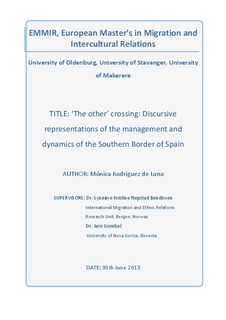| dc.description.abstract | Spain has undergone important transformations in its migratory patterns. In the last decades
the country began to observe a decrease in the net of emigration and an enlargement of the
immigration influx. Although the financial crisis has had a strong impact on the mobility
dynamics of the population in the country, which include a strong reduction in the
immigration rate, Spain continues to receive immigrants, including, irregular ones, that look
to settle in the country or to transit to others in the European space. The influx of irregular
immigrants who often arrive through means so precarious as ‘pateras’ (boats) to Spain, is also
observed in other southern European countries and as an established phenomenon, it has been
paralleled by the strengthening of the borders of ‘Fortress Europe’. The new forms of
governance emerging from the creation and expansion of the European Union have required
deep transformations in the way European societies interact with each other and with the rest
of the world, in order to come up with ways to manage and mitigate the intrinsic
contradictions, challenges and complexities present in this process, among which the
management of the external borders is central. As the migratory pressure rises, Europe faces
the difficult task of simultaneously controlling the influx of immigrants and respecting the
human rights and democratic values upon which it claims to be founded. These contradicting
aims are often pernicious to each other in borders where deportations, violence, brutal
encounters and vehement signs of rejection and exclusion are the rule everyday.
Borders, including the European external ones, are not only geographical limits. They are
institutions where values, interests, beliefs, feelings, imaginaries, and political and economic
objectives are synthesized, materialized and reflected. In the process of making Europe, new
border rules and practices have to emerge, as the European Union and its member states seek
to ensure the perpetuation of a particular order of the world where they maintain the
sovereignty over certain territories and populations. In this context, the importance of the
Spanish-Moroccan border is major, not only because of the geographical proximity between
Spain and Morocco, and therefore between Europe and Africa, in the area, but because, to a
great extent, of the strong migratory pressure it is the object of, the success of the political, economic and social agenda of Europe, depends greatly on the securing and control of its
borders. [...] | no_NO |
